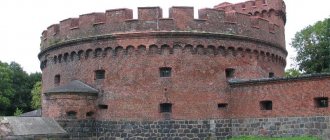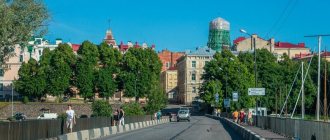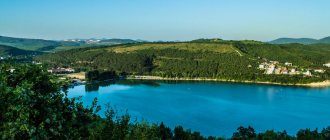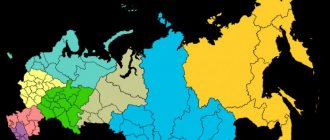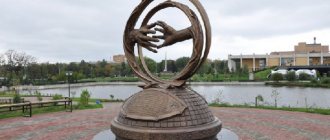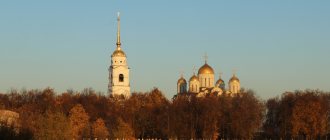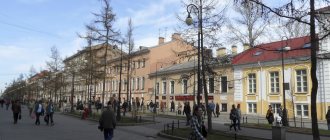Religion in Krasnoarmeysk
The majority of the ethnic population of the city professed reformism, a small part - Lutheranism. At the end of the 18th century, a Protestant parish appeared here, and in 1856 the parish of Baltzer was formed.
In the first years, religious services were held in a residential building, and in 1777 a wooden church appeared here. In 1821, another wooden church was built using donations from local craftsmen.
However, two small churches were not enough for all the believers, so a decision was made to build a new church, which began in 1849.
The church was built from local bricks, and the first service was held in it in 1851, and in 1856 it received parish status. In 1924, the church was reconstructed, the roof was covered with iron, funds for this were sent by people from Belzer who lived in the USA.
Unfortunately, in 1931, by order of the Communist Party, the prayer house was first closed, and in 1935, church services were stopped in the church, and a school was opened in the church itself.
The educational institution did not last long; in 1936 it was recognized as unsuitable for a school and was dismantled into bricks.
Krasnoarmeysk: the city of mosaic masonry
Until the middle of the last century, the Saratov region was also known as the territory of the Volga Germans. Since the time of Empress Catherine II, who invited the Germans to populate the deserted steppes of the lower Volga, the number of colonies has expanded and the number of their inhabitants has grown. By the time of the deportation in 1941, there were already about a million Volga Germans. Previously, we visited one of the most famous German colonies - Sarepta, now it is part of Volgograd.
In the Saratov region, one of the most famous colonies was Baltser, aka Pantsyr, aka Naked Karamysh, present-day Krasnoarmeysk. We went there to see if anything had survived from the former German colonies.
The mother colony of Balzer originated in 1765. In September, 11 families from the cities of Baden-Baden, Darmstadt, Isenburg, Kurpfalz and Switzerland arrived in the town on the banks of the Goly Karamysh River. The bulk of the settlers were from one region of Germany - Isenburg and Kurpfalz. The settlement was named after the first headman, Balzer Barnuli. The colony had this name for only three years, then it was renamed Naked Karamysh. The city became a Krasnoarmeisk city in 1942, when the Volga Germans had already been deported, and settlers from other regions of the USSR were settled here.
Over the course of a couple of centuries, the colonists managed to adapt well to the banks of the Volga. Thanks to their entrepreneurial spirit, the city became a real industrial center. By the revolution of 1917, in Goly Karamysh there were 23 sarpinka and 22 tanneries, an oil mill, a brewery, a power plant, and the trading house “Bender and Sons” operated. Horse-drawn carts, carding machines, winnowing machines and much more were made in the city.
What remains of the German colony today? Several brick buildings have been preserved and are in good condition. It is not difficult to recognize them - they are built using the brick mosaic technique. The walls are made of red and orange bricks. Construction materials were produced here. By the way, as they say, the secret of the mortar that was used to hold the bricks together has still not been figured out. Have you even tried?
German buildings have been preserved in the city center and are now used by various institutions. The most grandiose buildings by local standards are located on May 1st Street and they belonged to the same family - the Bender mansion and the Bender factory. All the Bender brothers - Egor, Yakov and Ivan - were entrepreneurs.
After the revolution, all the property of the merchants was requisitioned by the Soviet government. The factory building still houses knitting production. There is a social assistance center in the entrepreneur’s residential building.
On Lenin Street, 56, in a two-story building of German construction, today there are several institutions, including the editorial office of the regional newspaper “New Life”. In 1942, the Engels Machine Gun School was located in this building, which was located here until 1944. In front of the building in 2014, a small monument was erected in memory of the cadets who participated in the Great Patriotic War.
The central square of Krasnoarmeysk is Victory Square. On it is a traditional monument to the leader of the proletarian revolution. The sculpture of Lenin is a miniature of the monument in Saratov on Teatralnaya Square.
On the opposite side there is a memorial to soldiers who died in the Great Patriotic War and the Eternal Flame. The monument, authored by sculptor Shalva Zautashvili, was erected in 1975.
In the park behind the monument there are monuments to participants in local wars and liquidators of the Chernobyl nuclear power plant accident.
Nearby is a monument that evokes ambivalent feelings. The monument was erected to the soldiers of the special forces unit (CHON), who died in 1919-1921 while suppressing peasant riots. The monument is located above the mass grave in which the Red Army soldiers were buried. According to some reports, 30 people are buried here. In 1919, an uprising broke out in the city of Warnburg (now the village of Privalnoye). CHON members from Balzer came out to suppress the protest. Two detachments were formed in the city, commanded by the brothers Mikhail and Fyodor Wigandt. In Warnburg, 19 CHON members laid down their heads and were buried in one grave in the city cemetery. During the suppression of other riots, there were also those killed, they were buried next to their fallen comrades. According to some reports, in the grave lies the son of the merchant Andrei Bender, Robert, who fought for the Reds during the Civil War.
After a park was built on the site of the city cemetery in the 1920s, the mass grave was actually moved to the city center. In 1964, a monument was erected, the author of which was Saratov sculptor Georgy Epov. According to Soviet tradition, the opening of the monument was timed to coincide with November 7, the next anniversary of the October Revolution.
From the back of the monument, near the pedestal, a hole was exposed, covered with boards. It is possible that this is the covering of a mass grave of ChON members.
The city park is within walking distance from the monument. It has a children's playground and several exercise equipment. There are also monuments - six busts of Heroes of the Soviet Union, residents of the Krasnoarmeysky district. Next to them is a flat fountain, for some reason the water in it is greenish in color. Maybe this is the author's idea, or the water has become colored due to improper use of the fountain.
The local history museum in Krasnoarmeysk is located on Internatsionalnaya Street, 32. It is relatively young, it was opened in 1987 as a public museum of revolutionary, military and labor glory. Three years later it became a branch of the Saratov Regional Museum of Local Lore. In an old German house built at the beginning of the 20th century, several halls housed an exhibition traditional for such institutions. There is a small display case with stuffed animals and birds that live in the area.
One room tells about the life and everyday life of the German colony of Balzer. Much attention in the museum is paid to showing the development of weaving production in the city. As we wrote above, in Balzer there were more than two dozen factories that produced the famous sarpinka fabric.
In another room, exhibits tell about the events of the war years, the participation of area residents in hostilities and work on the home front.
It must be said that the exhibition is very archaic; the exhibits are in antediluvian glass cases. The museum clearly needs a good modernization.
The museum is open daily, except Mondays, from 09:00 to 17:00. Tickets are very inexpensive. For adults - 40 rubles, for children, students, pensioners, military personnel - 30 rubles. There is a separate fee for photography.
Next to the typical building of the regional palace of culture there is a small sculpture of an accordion player. Local residents said that this is a monument to a Red Army celebrity - the founder and leader of the Saratov harmonica ensemble “Naughty Bells” Vladimir Weiss. The team can be called a cultural brand of the Krasnoarmeysky region. Vladimir Weiss organized it in 1964, and now his son Alexander continues the business. The ensemble went on tour in several countries around the world - Czechoslovakia, Mozambique, East Germany. In 2014, “Naughty Bells” were participants in the cultural program of the Olympics in Sochi. However, now the monument is slightly peeling and needs restoration.
Sights of Krasnoarmeysk
In Krasnoarmeysk, a small number of pre-revolutionary buildings of German architects made of yellow and red bricks (made from local clay) have been preserved, the main feature of which is that the recipes for the mortars used during brick laying are still not known.
Most of these structures are from the late 19th century - early. 20th century, are located in the city center, they housed educational institutions, administrative offices and mansions of merchants and city nobility.
A local history museum has been operating in the city since 1987, the collection of which includes more than 9 thousand exhibits relating to various historical moments in the life of the city.
Also in Krasnoarmeysk there is a memorial to the fallen heroes of the Great Patriotic War with an Eternal Flame. In addition, the city is open:
- a monument at the Mass Grave to the fallen soldiers of the Red Army in the fight against the “white” gangs, it was opened in 1965;
- monument to Vladimir Lenin on Victory Square;
- monument to revolutionary V.T. Smolyaninov;
- a monument to fellow countrymen participating in the liquidation of the Chernobyl disaster;
- a monument to soldiers who died in local military battles;
- monument to cadets of the Engels Machine Gun School.
Krasnoarmeysk is not connected by rail; previously, the railway made it possible to get to the city of Karamysh, but in the 1990s. traffic was stopped, the tracks were dismantled, and the city retained a narrow-gauge railway, which is used by a ceramic factory to transport clay from quarries.
The narrow-gauge railway is one of the Red Army landmarks.
Krasnoarmeysk today
The urban district of Krasnoarmeysk was formed on March 12, 1947 and is located 45 km northeast of Moscow and covers an area of 15,643 hectares. The city is located on the banks of the picturesque Vorya River (a tributary of the Klyazma River) and is surrounded by protected forests with forest lakes. The hilly terrain creates the uniqueness of the urban landscape, which is closed from the north by Pirozhnaya Mountain, a favorite vacation spot for the townspeople.
Hundreds of enterprises in various industries are registered on its territory, such as the food industry, construction, production of building materials, packaging products and small-scale mechanization equipment.
The city-forming enterprises are scientific and production enterprises of defense significance.
The area of the Krasnoarmeysk urban district is 16,070 hectares. The population of Krasnoarmeysk as of January 1, 2015 is 26,594 people.
Historical reference
In the 16th century, the village of Muromtsevo stood on the territory of the future city of Krasnoarmeysk. In the early 30s of the 19th century, a cotton enterprise was founded here, later called the Voznesenskaya manufactory. In 1927, it became known as the textile factory named after the Red Army and Navy (KRAF), and the settlements that arose around the factory formed the village of Krasnoarmeysky in 1929.
In 1933-1934, in the forest north of the village of Krasnoarmeyskoye, the Sofrinsky artillery range, now the Federal State Unitary Enterprise "Research Institute "Geodesy", was put into operation and began to function, on the territory of which thousands of the latest types of artillery and missile weapons, ammunition, military and space technology.
The city of Krasnoarmeysk is part of the Moscow region of the Russian Federation. City status was assigned on March 12, 1947 by Decree of the Presidium of the Supreme Soviet of the RSFSR.
In accordance with Decree of the Presidium of the Supreme Council of the RSFSR No. 3470-1 of September 7, 1992, the city of Krasnoarmeysk was given the status of a city of regional subordination.
The municipal formation "City of Krasnoarmeysk" of the Moscow Region was given the status of an urban district by the Law of the Moscow Region of February 25, 2005 No. 57/2005-OZ. Since 2006, the name of the municipal entity is the Krasnoarmeysk urban district.
Krasnoarmeysk was formed as a city of science, implementing targeted state programs in the field of national defense. In order to increase the efficiency of advertising and exhibition activities in the field of military-technical cooperation of the Russian Federation with foreign states, to demonstrate the combat and operational capabilities of military products of the Ground Forces in the interests of foreign customers, Decree of the President of the Russian Federation dated June 11, 2004 No. 747 “On the creation of an open Joint Stock Company "Russian Center for Exhibitions of Military Products".
Outstanding fellow countrymen
Krasnoarmeysk has become a “small homeland” for many prominent people. Among them:
- Ya.Ya. Weber is an honored artist of the Volga Germans, the most famous paintings are “Grandfather Mazai and the Hares”, “Ice Drift”, “Twilight on the Volga”.
- A.S. Krasnov is a Soviet and Russian surgeon, Honored Traveler of Russia, inventor of the sports fleet.
- N.M. Skomorokhov is a military ace pilot, twice Hero of the USSR.
- V.V. Vorobyova is an Honored Artist of the Russian Federation, theater actress.
- Victor Glazovsky, Bishop of Glazovsky, was canonized in 2000.
- Ludwig von Platen was the first German settler; he became the author of the first literary work of German settlers, “Description of the journey of the colonists, as well as the way of life of the Russians, compiled by officer Platen.”
New in blogs
Krasnoarmeysk, near Moscow, next to which my country cottage is located, is a dead-end town: no highway passes through it. The Krasnoarmeyskoye Highway, a branch from Yaroslavka, leads into the city itself and ends there. That is, you can drive along it right through the entire Krasnoarmeysk (this continuation of the highway is called Ispytatelev Avenue) and come across a fire station, above which the banner of the Ministry of Emergency Situations flies. Then the road turns into Dachnaya Street, and in fact, that’s all. All other branches from this Dachnaya Street are local roads leading to several SNT, as well as to a spice factory, some kind of warehouse and a military unit. These roads can be conditionally called roads - they are broken, and you can only drive on them with trucks or SUVs. We somehow manage, knowing all the potholes and ruts by heart, to get to our village by car, swearing every time, according to the old Russian tradition...
I don’t know whether these outskirts of Krasnoarmeysk belong to the city itself or belong to the city of Pushkino (Krasnoarmeysk is part of the Pushkinsky district), but having lived here for 4 years, I see that the situation with the roads is not improving, and the pollution of the forest along these roads and the banks of the Vorya River, the favorite vacation spot of the Red Army soldiers, is taking on more and more menacing proportions every year. That is, on weekends the local population “relaxes” in the forest and on the banks of the river (on a grand scale, of course: with a lot of booze, bonfires, barbecues, chanson, etc.), and all the garbage remains at the resting place - for archaeologists of future generations, probably . There is no need to talk about the culture of the population here - this is not good old Europe, where every square centimeter of wildlife is worth its weight in gold. This is Mother Russia, with all its bells and whistles.
In the city of Krasnoarmeysk there was a mayor - Bulgakov. Of course, I immediately remembered his last name))). This mayor was convicted some time ago and sent to prison - he stole, they say. Now there is a new leadership in the city - I don’t know their names, I don’t know them personally, as they say... But neither this nor this leadership changes anything in the city - only a little commercial housing and an office center were built together with a Moscow company - for themselves and their surroundings, and also for the purpose of making money. The pride of Krasnoarmeysk is a relatively new stadium, built for the local women's football team "Rossiyanka" - the banner of Krasnoarmeysk. Millions of dollars are poured into this team, it travels to competitions all over the world, and, therefore, must host guests in decent conditions...Teams from different countries are brought to this stadium by buses from Moscow to the “Russians” - all sorts of championships are often held here. But these teams are driven strictly along the route “Moscow - Red Army Stadium”, and never set foot outside the stadium)))… Because what can foreigners see outside the stadium fence? Broken houses that have not been repaired for years, some of which are without amenities, the majority of the male population (and partly female) aged from 12-13 to 70 years old (rarely anyone lives past 70), drunkenly in the evenings and on weekends, crowds of young people mothers with strollers aged 15-17 years (in the evenings, young people have nowhere to go in Krasnoarmeysk - so they fuck the children... I’d rather not talk about the local recreation center - almost everything there is rented out) and all that?! By the way, people in Krasnoarmeysk are good. It's just a pity for them.
Those who are smarter and quicker, of course, work in Moscow or in Pushkino - they come to their homeland late in the evening and leave early in the morning... And those who work in the military unit or at the local one, where they do not pay wages for months (for me Several Red Army soldiers I know work there - so I’m fully aware) - poverty. It’s good that many of them have 6 acres left over from socialism... These 6 acres feed them. The city gives the impression of having fallen asleep under anesthesia: the saleswomen in the stores are sleepy, lazy - you want to buy something, but they don’t have change, the goods haven’t been counted, they went out to smoke, they’re trending on their cell phones... At the market, as elsewhere in Russia, there are almost no Russian sellers, but life is in full swing: deception, body kit, unsanitary conditions... But! One of the local bars has striptease on Sundays!)))
...Somehow I went crazy today - I rolled out such a canvas! I myself don’t understand where this anger awoke in me? Why, in the midst of the July peace and lazy heat, did I suddenly feel so hurt and offended for this small town near Moscow?!
Because, probably, when I visit other cities near Moscow, which are growing and becoming more beautiful every year, where roads, modern cinemas, hospitals are being built, new jobs are being created, I sometimes think: “Why is everything so bad in OUR Krasnoarmeysk?! »
